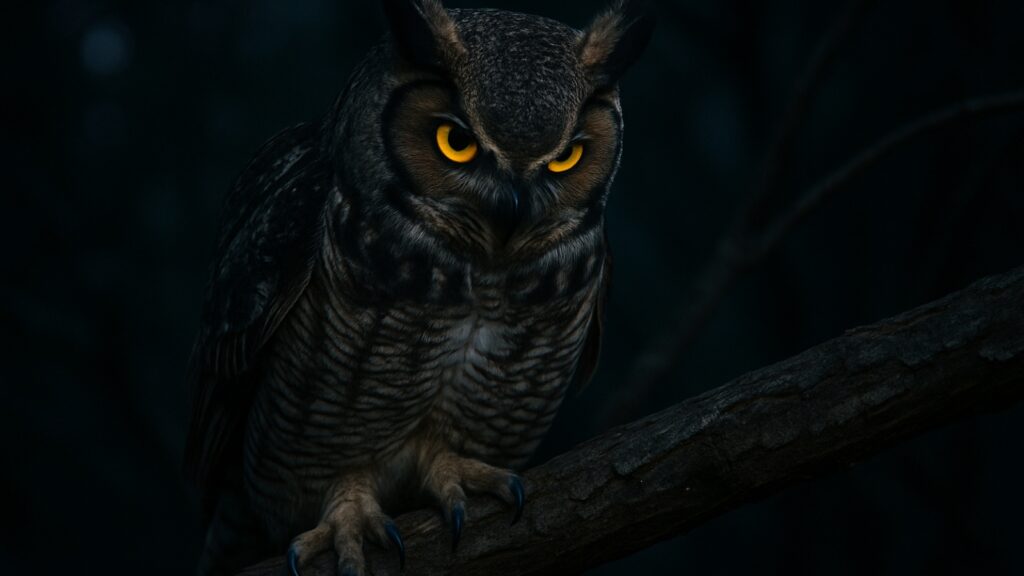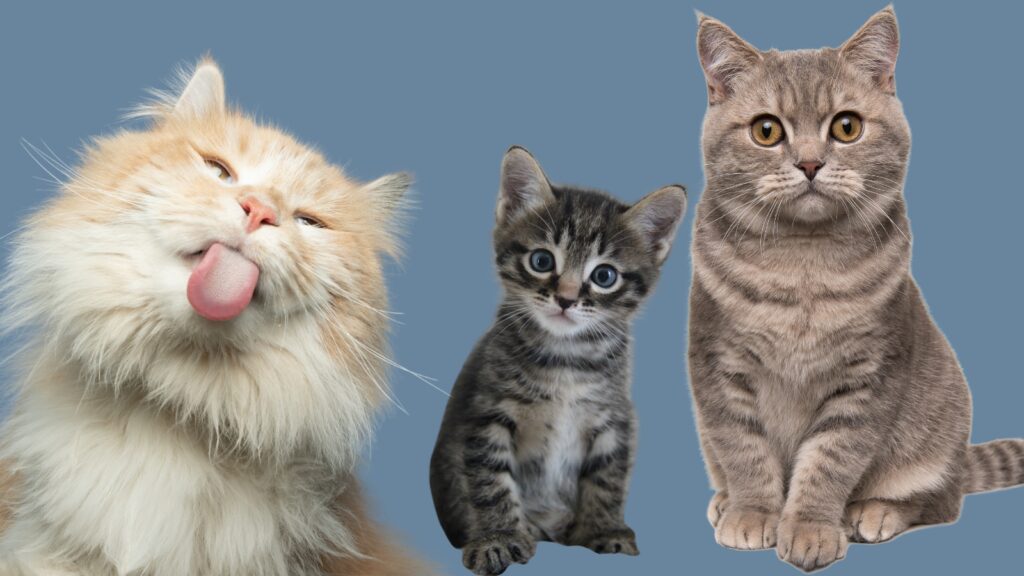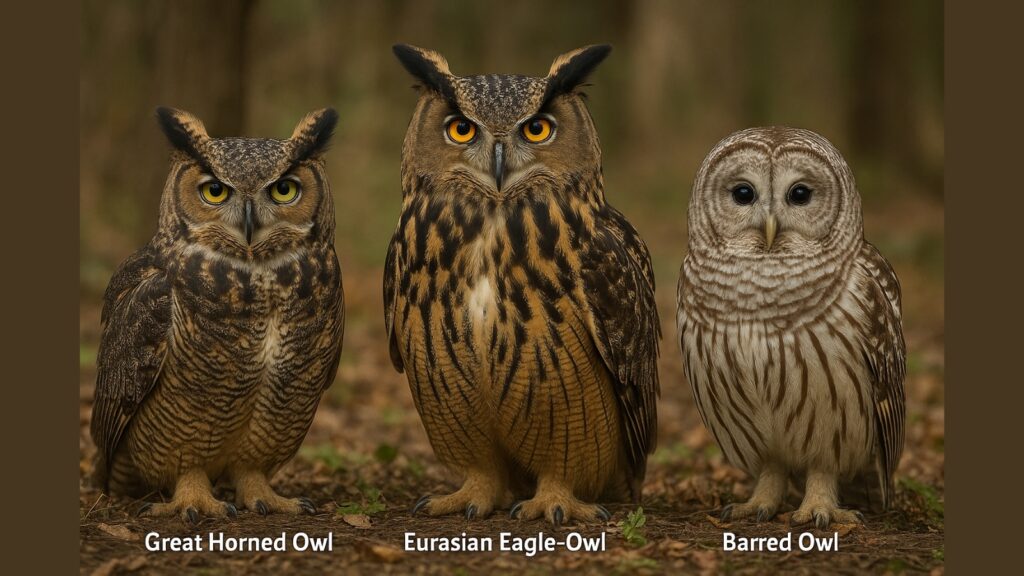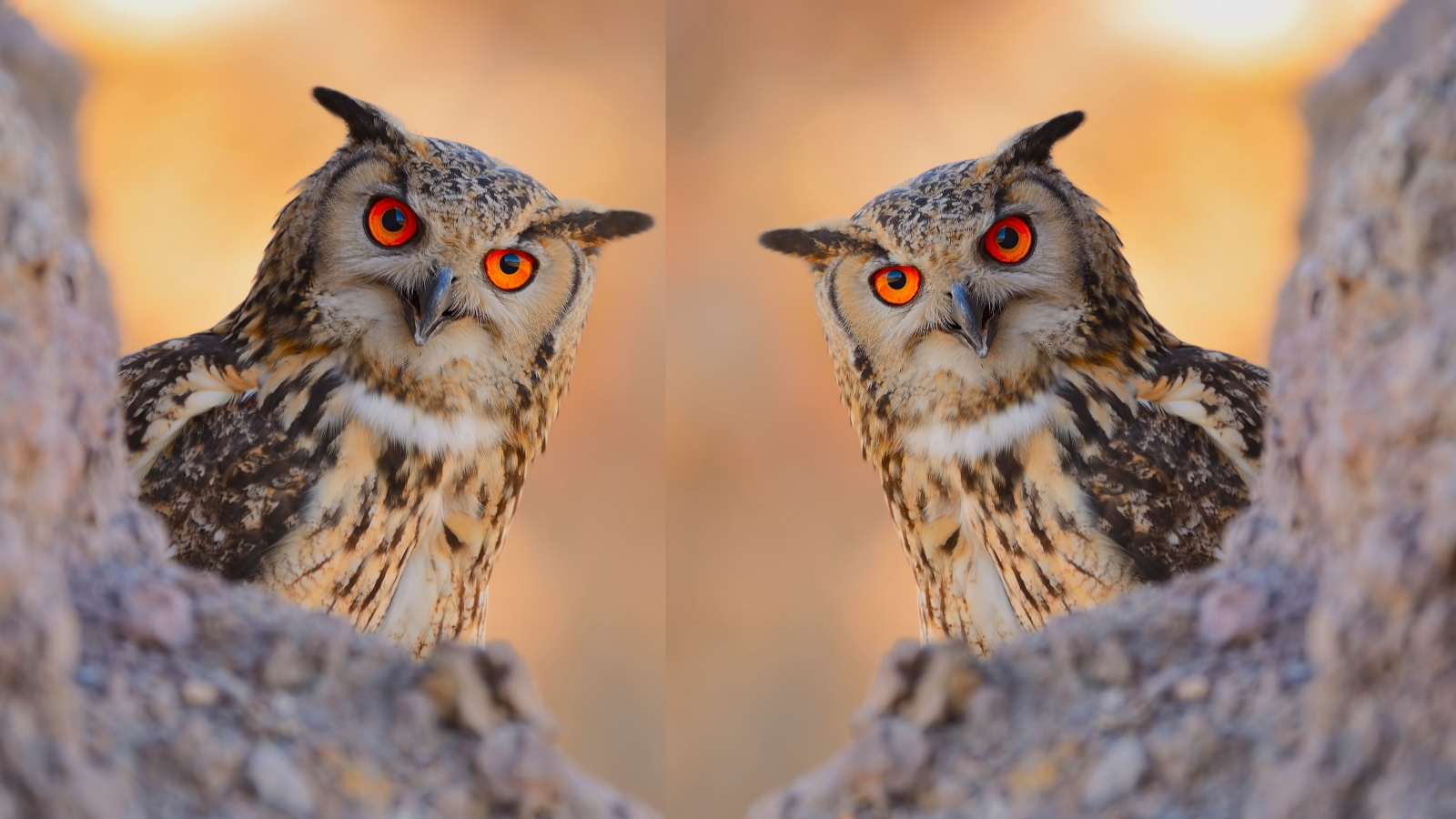While large owl species like the Great Horned Owl can and occasionally do attack cats, especially smaller ones, such incidents are relatively rare. Most cats are too large for owls to carry away, though kittens and very small cats (under 5 pounds) may be at risk. The greatest danger comes from the largest owl predators, and primarily at night when these nocturnal hunters are actively hunting.
The question of whether owls pose a threat to our feline companions is one that many cat owners living near wooded areas or rural environments often worry about. With their silent flight, powerful talons, and nocturnal hunting habits, owls certainly seem like formidable predators. But are domestic cats really on their menu?
In this comprehensive article, we’ll explore the relationship between owls and cats, examining which owl species might pose a threat, how common such attacks actually are, and what preventative measures cat owners can take to protect their pets.
By understanding the facts and separating myths from reality, cat owners can make informed decisions about their pets’ safety when it comes to sharing territory with these magnificent birds of prey.
Key Takeaways:
- Great Horned Owls are the owl species most likely to attack cats in North America
- Cats weighing under 5-10 pounds are at greatest risk of owl predation
- Most documented owl attacks on cats occur at night when owls are actively hunting
- Keeping cats indoors, especially from dusk to dawn, is the most effective protection
- Large adult cats (over 12 pounds) face minimal risk from owl attacks
- Owls typically can only carry prey weighing about half to two-thirds of their body weight
- Specialised owl-proof enclosures like “catios” can provide safe outdoor access for cats.
Owl Species and Their Predatory Capabilities
Which Owl Species Are Most Likely to Attack Cats?
Not all owl species pose a threat to domestic cats. The risk depends largely on the owl’s size, hunting behaviour, and geographic location. Here are the primary owl species that might view a cat as potential prey:
Great Horned Owl (Bubo virginianus)
The Great Horned Owl is often considered the most formidable owl predator in North America. These powerful birds typically weigh between 2-3 pounds (0.9-1.4 kg) but can exert an astonishing 400 pounds of pressure per square inch with their talons. They have been documented attacking prey much larger than themselves, including cats, skunks, and even other raptors.
Great Horned Owls are known for their impressive strength and aggressive hunting tactics. They have a diverse diet that includes mammals larger than themselves, and there are well-documented cases of these owls attacking and killing domestic cats, especially smaller ones.
Eurasian Eagle-Owl (Bubo bubo)
Found across Europe and Asia, the Eurasian Eagle-Owl is one of the largest owl species in the world. Weighing between 4-8 pounds (1.8-3.6 kg) with a wingspan reaching up to 6.6 feet (2 meters), these impressive birds can potentially take prey larger than the Great Horned Owl. In regions where they exist, they pose the most significant owl threat to cats.
Barred Owl (Strix varia)
Though less commonly associated with attacks on pets, Barred Owls have been documented occasionally preying on cats, especially kittens or very small cats. They typically weigh between 1-2.5 pounds (0.45-1.1 kg) and primarily hunt smaller mammals, but trail camera footage has captured instances of them attacking adult cats.
Related article: Complete Owl Identification Guide.

Physical Capabilities and Hunting Behaviour
Owls possess several adaptations that make them extraordinary hunters:
- Silent flight: Special feather adaptations allow owls to fly almost completely silently, making them extremely effective ambush predators
- Powerful talons: An owl’s grip strength is their primary killing mechanism, with some large owls capable of exerting hundreds of pounds of pressure per square inch
- Excellent night vision: Owls can see in light levels up to 100 times lower than humans can
- Precise hearing: Many owl species can locate prey by sound alone, even beneath snow or vegetation
- Hunting strategy: Owls typically attack from above and behind, gripping prey with their talons and often killing instantly by severing the spinal cord.
The Reality of Owl Predation on Cats
How Common Are Owl Attacks on Cats?
Despite the physical capabilities of larger owl species, attacks on domestic cats are relatively uncommon. Several factors contribute to this:
- Size mismatch: Most adult domestic cats (averaging 8-10 pounds) are simply too large for most owls to carry away
- Risk assessment: Owls, like most predators, make risk assessments before attacking prey. Cats are armed with sharp claws and teeth that could potentially injure an owl
- Food preference: Most owls prefer smaller prey like rodents, which provide adequate nutrition with less risk
- Habitat separation: In many areas, cats are primarily active in more developed environments where large owls are less common.
According to the International Owl Centre, while large owls do occasionally attempt to catch and kill small cats and very small dogs, such incidents are relatively rare. When they do occur, they typically involve smaller cats or kittens weighing under 5 pounds.
Documented Cases and Evidence
While specific statistics on owl predation of cats are limited, there are documented cases and evidence supporting that it does occur:
- Trail camera footage has captured both Great Horned Owls and Barred Owls attacking adult cats
- Wildlife rehabilitation centres occasionally treat cats with injuries consistent with owl attacks, typically puncture wounds from talons
- A documented case from Alaska reported a Great Horned Owl attacking several pets, including cats, over a four-day period
- Multiple online forums contain anecdotal reports from pet owners who have witnessed owl attacks on their cats or found evidence suggesting such attacks.
Weight Limitations and Physical Constraints
One critical factor limiting owl predation on cats is the bird’s carrying capacity. As a general rule, owls can only lift and carry prey weighing about half to two-thirds of their own body weight:
- A Great Horned Owl (2-3 pounds) can typically carry prey weighing up to 2 pounds
- The Eurasian Eagle-Owl (4-8 pounds) may be able to carry up to 4-5 pounds
- Most other North American owl species are simply too small to carry an adult cat
This doesn’t mean larger cats are completely safe, an owl might still attack a larger cat on the ground—but it does significantly reduce the risk for most adult cats.
Protecting Your Cat from Owl Predation

Identifying High-Risk Scenarios
Certain situations increase the likelihood of owl-cat encounters:
- Time of day: Owls are most active at night, particularly in the hours after sunset and before sunrise
- Season: Breeding season and winter months, when food is scarce, may increase predatory behaviour
- Location: Rural areas, woodland edges, and open spaces near natural habitats pose higher risks
- Cat characteristics: Small cats, kittens, elderly cats, or those with limited mobility face greater danger
- Cat behaviour: Cats that freeze when startled rather than run may be more vulnerable.
Prevention Strategies
To minimise the risk of owl attacks on cats, consider implementing these protective measures:
Keep Cats Indoors
The most effective prevention strategy is to keep cats indoors, especially from dusk until dawn when owls are most actively hunting. Indoor cats live longer, healthier lives overall, protected not just from owls but from numerous other hazards, including traffic, disease, and other predators.
Create Protected Outdoor Spaces
If your cat enjoys outdoor time, consider building a “catio” or enclosed outdoor space with a solid roof or mesh small enough to prevent owl access. This allows cats to experience the outdoors while remaining protected.
Supervision and Deterrents
When cats are outdoors:
- Supervise them directly, especially during dawn and dusk
- Install motion-activated lights in your yard
- Consider owl deterrents like reflective objects or predator eye balloons
- Create covered pathways between structures if cats need outdoor access.
Visual Deterrents
Some visual deterrents that may help keep owls away include:
- Reflective tape or spinners
- Motion-activated sprinklers
- Changing patterns of deterrents regularly (owls are intelligent and may become accustomed to static deterrents).
Myths vs. Facts About Owl Predation
Common Misconceptions
Several misconceptions exist regarding owls and their relationship with cats:
Myth: All owls are a threat to cats
Fact: Only the largest owl species poses any significant threat to domestic cats. Smaller owls like Screech Owls or Saw-whet Owls are more likely to be prey for cats than predators.
Myth: Owls regularly hunt and eat cats
Fact: While large owls are capable of attacking cats, such incidents are relatively rare. Owls primarily hunt smaller, less dangerous prey like rodents.
Myth: Owls can carry off large cats
Fact: Most owls can only carry prey weighing about half to two-thirds of their body weight. This means even the largest owls typically cannot lift cats weighing over 5-10 pounds.
Myth: Cats cannot defend themselves against owls
Fact: Adult cats are armed with sharp claws and teeth and can potentially cause serious injury to an attacking owl. This risk often deters owls from targeting all but the smallest cats.
Scientific Understanding
Research on owl diet: Scientific studies of owl pellets (regurgitated indigestible parts of prey) rarely show evidence of cat remains, indicating that cats do not form a significant portion of owl diets.
Predator-prey dynamics: Predators typically avoid prey that poses a significant risk of injury, and most healthy adult cats fall into this category for all but the largest owl species.

Understanding Owl Diet and Hunting Behaviour
Natural Prey Preferences
Owls are carnivorous birds that have evolved to hunt specific prey types. Their diet varies by species but typically includes:
- Small rodents (mice, voles, rats)
- Rabbits and hares
- Small birds
- Insects and arthropods
- Reptiles and amphibians
- Fish (for specialised fishing owls).
For most owl species, small mammals like mice and voles constitute the bulk of their diet. The largest owls, such as Great Horned Owls and Eurasian Eagle-Owls, have more varied diets that may include larger prey like rabbits, skunks, and occasionally small pets.
Hunting Techniques
Owls employ several sophisticated hunting techniques that make them effective predators:
- Perch and pounce: They sit on an elevated perch surveying the area, then swoop down silently when prey is detected
- Quartering: Flying low over open areas, scanning for prey movement
- Ambush predation: Waiting near areas where prey is likely to appear
- Crushing kill technique: Using powerful talons to squeeze prey, often causing quick death by severing the spine or crushing vital organs
Territorial Behavior
Owls are highly territorial birds, particularly during breeding season. They may become more aggressive when defending nesting sites and their young. Understanding this behaviour can help predict times when owls might be more likely to clash with domestic animals, including cats.
When Cats and Owls Coexist
Mutual Threats
The relationship between cats and owls is not one-sided. While large owls can potentially prey on small cats, the reverse is also true:
- Outdoor cats kill billions of birds annually, including owls
- Small owl species and owlets (baby owls) are vulnerable to cat predation
- Cats and owls often compete for the same prey resources
This complex predator-prey relationship varies depending on the sizes of the particular cat and owl involved, as well as environmental factors.
Ecological Considerations
From an ecological perspective, both cats and owls have important roles:
- Owls serve as natural rodent control and are important components of healthy ecosystems
- Feral and free-roaming domestic cats can have significant negative impacts on wildlife populations
- Conservation efforts increasingly focus on protecting native predators like owls while encouraging responsible pet ownership
Conclusion
While large owl species like the Great Horned Owl or Eurasian Eagle-Owl are physically capable of attacking and killing small cats, such incidents are relatively rare. The risk is primarily limited to smaller cats and kittens weighing under 5-10 pounds, and most attacks occur at night when owls are actively hunting.
For cat owners concerned about owl predation, the most effective solution is keeping cats indoors, especially from dusk to dawn. For those who allow outdoor access, supervised time outdoors, enclosed “catios,” and being aware of local owl populations can help minimise risk.
Understanding the realistic threat level, significant for very small cats but minimal for larger adult cats, can help pet owners make informed decisions about their cats’ safety while still appreciating the important ecological role that owls play in our environment.
Frequently Asked Questions (FAQ)
Q: What kind of owls eat cats?
A: The Great Horned Owl is the owl species in North America most likely to attack cats. In Europe and Asia, the larger Eurasian Eagle-Owl poses the greatest threat. Barred Owls have also been documented occasionally preying on cats.
Q: How big of a cat can an owl carry away?
A: Most owls can only carry prey weighing about half to two-thirds of their own body weight. Even the largest owls typically cannot carry more than 4-5 pounds, meaning most adult cats are too heavy to be carried off.
Q: Are small dogs also at risk from owl attacks?
A: Yes, very small dogs (under 5-10 pounds) may face similar risks as small cats, particularly from Great Horned Owls. Dogs should be supervised outdoors at night in areas with known large owl populations.
Q: How common are owl attacks on cats?
A: Owl attacks on cats are relatively uncommon. While no precise statistics exist, they’re considered rare events rather than a regular occurrence, even in areas where owls and outdoor cats coexist.
Q: Can cats defend themselves against owls?
A: Adult cats have sharp claws and teeth that can potentially injure an owl. This defensive capability often deters owls from attacking all but the smallest cats. However, an owl’s silent approach may prevent cats from detecting the threat until it’s too late.
Q: What time of day are cats most at risk from owls?
A: Cats are most at risk from dusk until dawn, when owls are actively hunting. The hours immediately after sunset and before sunrise typically represent peak hunting times for most owl species.
Q: How can I tell if an owl has attacked my cat?
A: Injuries from owl attacks typically include puncture wounds from talons, often in sets of four aligned in a pattern. The wounds may be deep and can be found on the back, head, or shoulders of the cat.
Q: Will lights deter owls from my yard?
A: Motion-activated lights may help deter owls temporarily, but owls can become habituated to regular lighting. Varying deterrent methods is more effective than relying on a single approach.
Q: Are certain cat colors more at risk from owl predation?
A: There’s no scientific evidence that cat color affects owl predation risk. Owls rely more on movement detection than color recognition when hunting, especially at night.
Q: Can owls break through screening or netting to get to a cat?
A: Large owls have strong talons that could potentially tear through lightweight mesh or netting. For effective protection, outdoor cat enclosures should be constructed with heavy-duty materials and small mesh sizes (2″ x 2″ or smaller).
Other Recommended Resources:
- National Park Service. “Owls – Big Bend National Park.” https://www.nps.gov/bibe/learn/nature/owls.htm
- Chesapeake Bay Program. “Great Horned Owl Bubo virginianus.” https://www.chesapeakebay.net/discover/field-guide/entry/great-horned-owl
- The Peregrine Fund. “Great Horned Owl.” https://peregrinefund.org/explore-raptors-species/owls/great-horned-owl
- University of Pennsylvania. “Comparing Owls.” https://www.sas.upenn.edu/~dixonmj/comparingowls.pdf
